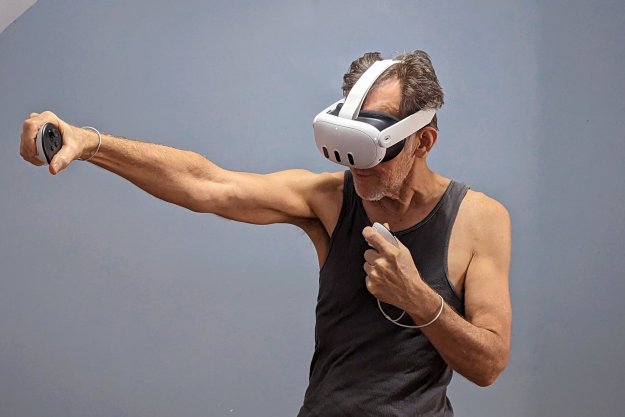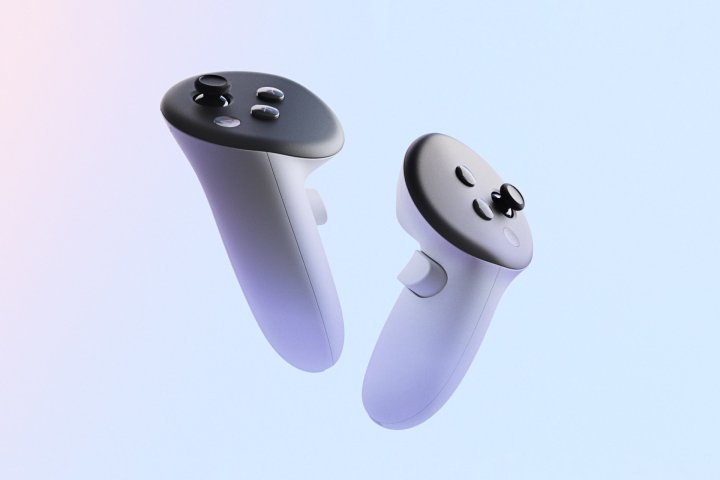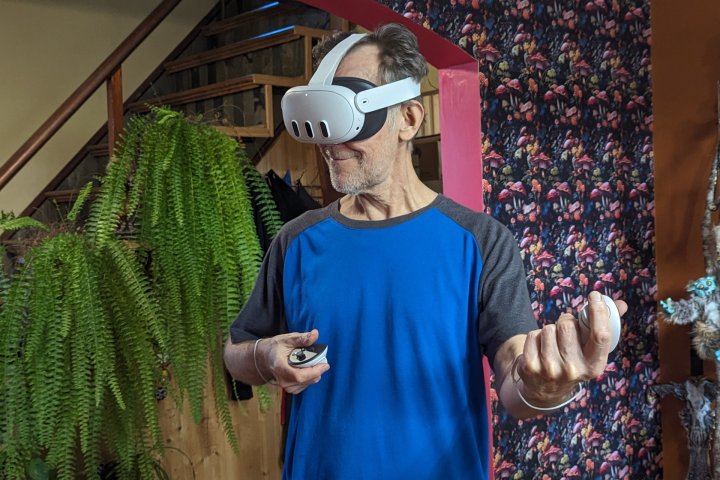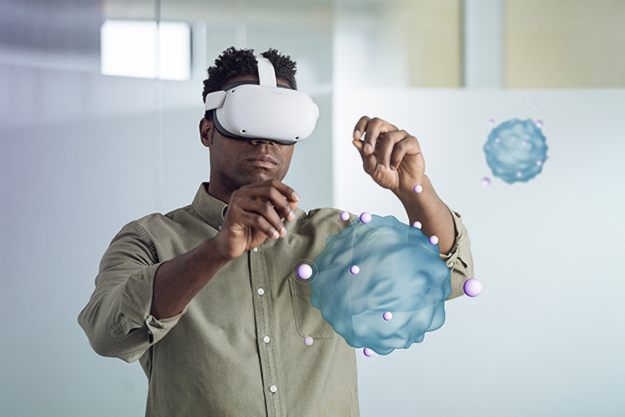
“If you’ve been sitting on the VR sidelines, the near-perfect Meta Quest 3 is the headset you’ve been waiting for.”
- Doubles Quest 2 GPU performance
- Crisper graphics with 30% more pixels
- Sharp, clear lenses without god rays
- Mixed reality is good enough to use a phone
- Depth sensor automatically maps your room
- Ringless controllers are less breakable
- Great price for a powerful VR headset
- Battery is still in front, adding face pressure
- Passthrough cameras are good, not great
- No silicone cover included
The Meta Quest 3 just might change your mind about VR gaming. If you’ve been waiting and watching for VR headsets to reach a level of quality that’s worth your attention, that time has come.
At a very affordable price, you can get a high-quality VR headset that has a bright, sharp display and doubles as a mixed reality device. It’s a way to enjoy the AR future we all want before powerful enough AR glasses arrive. It’s easy to set up and removes almost every barrier to enjoying virtual reality. I’ll start off with the technical details, then delve into why the Quest 3 might be a game changer for VR.
How fast and sharp is the Meta Quest 3?

Meta’s Quest 3 makes a significant leap over earlier standalone VR headsets, catching up with current technology after falling behind for many years. The display is much better than the one on the Quest 2, packing in 30% more pixels and widening the sweet spot with new pancake lenses that eliminate god rays and make graphics crisp.
The Quest 2 was a worthy headset in 2020 and continued to offer the best VR solution for three years. Meta’s optimization efforts are almost miraculous, delivering impressive hand-tracking and rendering capabilities on this aging hardware. However, it really is time for something new, and now it’s here.
With Qualcomm’s latest extended reality processor, the Snapdragon XR2 Gen 2, the Quest 3 roughly doubles the performance of the Quest 2. The GPU is more than twice as fast. Qualcomm hasn’t shared a direct CPU comparison, but the Snapdragon XR2 Gen 1 was based on the Snapdragon 865 processor, while the Snapdragon XR2 Gen 2 has more performance cores than the Snapdragon 8 Gen 2. The CPU will be at least 40% faster based on a comparison of the mobile chips.

With its newer chip, the Quest 3 also benefits from three years of XR advances, greater efficiency, and faster connectivity. Dedicated algorithms for tracking and image reprojection exist in the chip to allow the Quest operating system and apps to focus on other details. Wi-Fi 6E is fast and reliable.
Meta eased the throttling of the Quest 2 to extend its life, but some people have complained that it gets hot. The Quest 3 breezes through the same tasks with no heat, while delivering a 30% higher resolution. Everything is crisper, snappier, and more dependable.
How good is the Quest 3’s mixed reality?

Mixed reality means your actual surroundings are shown within the Quest 3 through the use of color passthrough cameras on the front. The challenge is making this look the same as if you weren’t wearing a VR headset.
Since the cameras are about an inch in front of your eyes, changing the perspective is enough to be disorienting. The Quest 3 uses math to recalculate and reproject the scene before displaying it in the headset so it’s aligned correctly for your eyes.
The result is pretty convincing, particularly when used for gaming. It’s not perfect, but when I’m blasting invading blobs, I’m not focused on the background.
When examining the passthrough with no distractions, I can see minor glitches. If I move my hands in front of the headset, there’s a ripple as the reprojection adjusts to optimize for the closer object.
The Quest 3 passthrough image is good enough that I can use my phone without removing the headset. That was impossible with the Quest 2 and wasn’t worth the extreme effort required to do so with the Quest Pro. The resolution isn’t so good that I would use my phone for an extended period that way, but it’s usable.

The Quest 3 can easily capture screenshots that include mixed reality, as you can see in the images above. Both phones are set to medium brightness. With a Quest Pro, the screens are completely whited-out unless the brightness is very low.
Controllers without rings

Meta has removed the rings on the Quest 3’s Touch Plus controllers, eliminating the risk of crashing rings together when caught up in a game. The Quest Pro’s Touch Pro controllers were also ringless, but included their own embedded processors and cameras to handle tracking. Meta managed to lose the rings on the Quest 3 without so much hardware expense.
There was some concern that Touch Plus controllers would fall short of Quest 2’s performance in fast action, but the Quest 3 managed to keep up with quick strikes in any direction. The Touch Pro controllers still have the advantage of being visible even when held behind my back.
Quest 3 owners can buy Meta’s most advanced controllers separately if that additional accuracy is important.
Quest 3 comfort

For VR, comfort is critical, yet major manufacturers have overlooked this issue. The Quest Pro was supposed to be a breakthrough in wearability, and for some it was. Others had issues with the forehead pad. Sony’s PlayStation VR2 had the same problem. When the head pad coincidentally matches your forehead shape, it’s wonderful. Otherwise, you have to find solutions to make the expensive new headset usable.
It’s too early to know how well the Quest 3 will work for others, but I found it comfortable for extended periods of time. Even the standard head strap has three points of adjustment to optimize the fit. Like the Quest 2, the hinge pivots and the length of the center strap is adjustable. Unlike the Quest 2, there’s also a circumference adjustment.
By tightening the back strap and adjusting the top strap, I can fine-tune the fit for stability and comfort that suits the game or app I’m using at the moment. The IPD (eye-spacing adjustment) range is very wide at 53mm to 75mm. Via two buttons inside the facial interface, I can lengthen it to accommodate glasses.
The 40% slimmer profile reduces the lever effect that makes front-heavy VR headsets press into your face. The overall effect is a headset that feels lighter and more comfortable with the standard strap. I had to order an expensive Elite strap to enjoy the same comfort with my Quest 2.
My skin is sensitive and wearing a standard VR headset for 30 minutes or more irritates my face. A silicone cover (not included) helps, but isn’t a perfect solution. For that reason, my Quest Pro will remain my primary headset. It’s the one and only VR headset I’m aware of that rests on my forehead, not my nose and cheeks.
There’s nothing preventing third-party VR accessory manufacturers from creating a similar free-floating solution for the Quest 3, and I would welcome it. That’s not possible with the Quest 2 since its Fresnel lenses can’t be exposed to external light without showing strong god rays. The Quest 3’s pancake lenses don’t have this issue.
Quest 3 is a game-changing VR headset

At the top of the article, I described the Quest 3 as a game-changing device since it solves so many common complaints about virtual reality, such as:
- My computer isn’t VR-ready
- Setup is too complicated
- VR headsets cost too much
- I’m afraid of punching my TV
- Standalone VR is too slow and has poor picture quality
- There aren’t any compelling VR games
- VR games are too expensive
Since the Quest 3 is a standalone system, you don’t need a computer to enjoy high-quality VR games. The graphics are good. PC VR can be better, and if you demand more than the Quest 3 offers, you can wirelessly connect the Quest 3 to your PC to play Half-Life: Alyx and other VR games that require tens of gigabytes of storage.
Setup is super quick; just scan a QR code on your phone with the Quest 3’s cameras and download games. Meta includes a decent web browser, video player, a few basic games, and more on the headset to keep you busy while the bigger games download.
At $500, a Quest 3 costs about the same as a gaming console, but opens up a new world of experience.
Since the Quest 3 automatically maps your environment, you don’t have to fuss with drawing a guardian border like on previous versions. Just look around the room for a few seconds and a colorful grid will fade in if you get too close to objects.

With a processor that’s better than what’s found in many mobile phones, the Quest 3 can render high-quality graphics at a fast pace while tracking your hands or controllers in 3D space.
Meta just announced several exciting new VR games, including Asgard’s Wrath 2, which will feature a massive world with 60 hours of gameplay, Assassin’s Creed Nexus VR, and Arizona Sunshine II. Many more are coming soon. The Quest platform already has plenty of compelling gaming titles, such as Red Matter, The Walking Dead: Saints and Sinners, Resident Evil 4, Beat Saber, Pistol Whip, and Superhot.
The list of great VR games goes on and on. Now mixed reality games will rise in popularity as well, bringing VR action into your personal space. Complex animated tabletop gaming is easy with the Quest 3, and Demeo is a great example. You can even experience a zombie attack in your home with games like The Cabin, which now offers a mixed-reality mode where creatures start creeping through your windows and popping out of doors.
Meta’s new Quest+ subscription service lets you build a library of VR games for a low monthly fee.
The Meta store has free games as well. Population: One is a free battle royal reminiscent of Fortnite. Horizon Worlds has become a proper multiplayer, cross-platform game environment, and Meta recently added two great games, Super Rumble and Citadel, with more in progress.
Now’s the time for VR

If you’ve been sitting on the sidelines waiting for the right moment to try VR, now is the time. Meta’s Quest 3 will be hard to beat in terms of value. You’d have to spend thousands of dollars to get a better experience, and even then, some headsets fall short.
For $500, you get a high-quality VR headset that doesn’t require any other gear. For more games, connect the Quest 3 to a VR-ready gaming PC. Storage is 128GB, which is enough for several standard games and a couple of big ones. For a luxurious amount of storage, you can get the 512GB model for $650.
If you already own an older VR headset, consider upgrading. The 2,064-by-2,208 pixel per eye resolution is noticeably crisper than on the Quest 2 and the pancake lenses provide a wide sweet spot of clarity. The volume is 40% louder, and the audio quality is great. Personally, I wouldn’t use earbuds unless I needed to limit sound leakage.
I strongly recommend the Meta Quest 3 to anyone, even if you’re considering the Apple Vision Pro. It might take a year or more for Apple’s library of VR titles to reach a satisfying depth. Meanwhile, the Quest 3 can run all Quest 2 games with better-quality graphics without slowing the frame rate. Some developers are already updating games to take full advantage of the Quest 3 hardware.
The Quest 3 offers incredible value right now and will continue getting better with Meta’s ongoing software updates that keep the hardware working its best even after years of service. If you haven’t ordered one yet, buy a Quest 3 today. You won’t regret it.
Editors' Recommendations
- Jackbox Naughty Pack is the M-rated party game you’ve been waiting for
- Cyberpunk 2077: Ultimate Edition is the complete package you’ve been waiting for
- The best Meta Quest 2 games
- The Meta Quest Pro and Quest 2 are getting big price cuts this month
- Razer’s first VR accessories aim to make the Meta Quest 2 more comfortable




